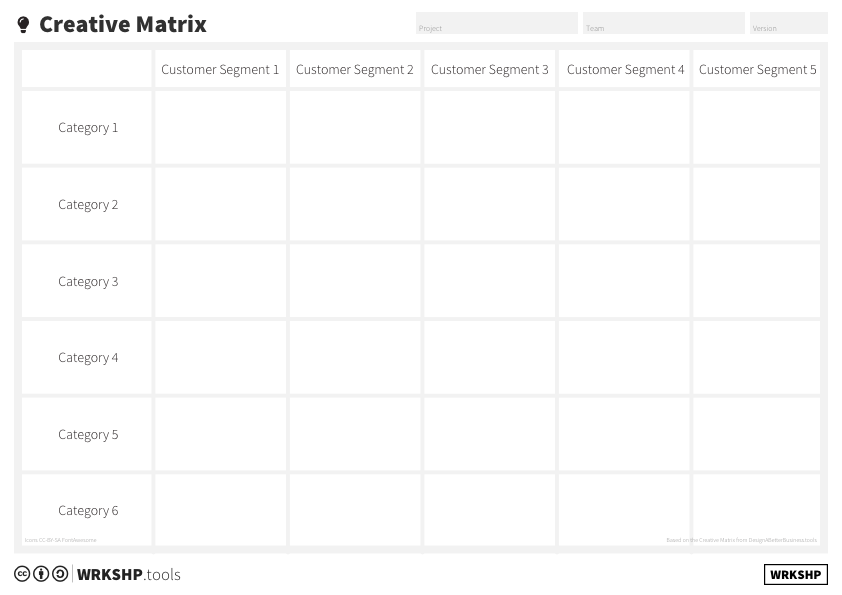Creative Matrix
The creative matrix is an alternative way of getting to a large collection of new ideas quickly. When you’re finding that everyone’s ideas are too similar, it’s time to expand the boundaries of your thinking with the Creative Matrix.
Use this tool when:
- you want to generate a large amount of options quickly.
- you want to avoid a group’s first instinct to jump to what they think is the solution.
- you want to come up with ingredients for a richer picture of the problem
Overview
| Time | ± 20 minutes | |
| Difficulty | 2 / 5 | |
| People | 3 - 5 | |
| Author | erik van der pluijm | |
| Website | https://designabetterbusiness.tools | |
| License | CC BY SA 4.0 |

What is it and why should I use it?
The creative matrix is an alternative way of getting to a large collection of new ideas quickly. When you’re finding that everyone’s ideas are falling in and around the same areas of exploration, it’s time to expand the boundaries of your thinking. This is a perfect time to use a creative matrix.
The goal of ideation is to expand the thinking and ideas of everyone on the team, to create something that is greater than the sum of its parts. However, without context and practice, most of us have a tough time expanding beyond what we know (or came up with in the shower).
The creative matrix was designed with this in mind. Essentially, the creative matrix is a tool that will help spark new ideas at the intersections of discrete categories. This tool is all about divergent thinking. Best of all, you get to design your own creative matrix based on your design criteria, the market you play in, or the customers you serve (or wish to serve).
Tip! The matrix as displayed here uses ‘customer segments’ as the horizontal axis, but you are free to use any axis you like. By doing this, the creative matrix can be used for much more than to generate possible business model options. For instance, how about placing ‘Stakeholders’ on the horizontal axis for storytelling or sales ideas? How about having different delivery strategies? Competitors? Or products? The matrix works in all these cases.
Tool Overview

Customer Segments Add different customer segments or sub-segments here
Categories Add different categories here (see below for examples)
Ideas Every cell in the matrix holds at least one idea, combining a customer segment with a category.
Steps
1 Setup
To design your own creative matrix, draw a grid on a whiteboard or poster paper with no more than five rows and five columns. Give it a topic or a central “how might we...?” question.
For each of the columns, designate a customer segment (existing or new). For each of the rows, designate a particular technology, need, or value proposition.
- Customer Need
- Value Proposition
- Revenue Model
- Channel
- Customer Relationship
- Technology
- ...
You might opt to designate the last column and/or row as a wildcard category, for placing open ideas that don't fit in any of the cells.
When generating ideas around a new investment product for a bank, we came up with customer (sub)segments such as ‘affluent young professionals’, ‘hi-potentials’, and ‘double-income families’. We came up with different categories influenced by quotes from our first interviews with customers, such as: ‘Daily habit’, ‘Easy’, ‘Bragging Rights’, ‘Ecological’, ‘For the Future’, and ‘Bank in your pocket’.
2 Diverge
With your matrix in place, it’s time to ideate! Using sticky notes, have each person randomly and rapidly add as many ideas as they can come up with to the cells in the matrix. Words are good. Pictures are better! The goal is to fill in every single cell in the creative matrix with at least one idea. You're done when all the cells have been filled!
To incentivise people to generate more ideas, assign a point for each sticky note. The highest total score wins.
Combining the customer segments with the categories helped to spark new ways of thinking that went beyond ‘we need to build an app’. Thinking about how a specific ‘category’ might show up for a segment can help you create a deeper story, which helps spark new ideas.
3 Converge
Once every cell has been filled in and the time limit is up, it’s time to review everyone’s ideas. Have the team huddle around the creative matrix as if it were a priceless painting.
Have the persons that placed the sticky notes explain in one or two sentences what that sticky note is about.
Once everyone has had an ample chance to look at each other’s work, have each person call out their favourite ideas (or top two). Use for instance dot voting or secret voting to find the top ideas.
4 Next Steps
Select the ~3-5 most promising ideas to move forward with and base for instance an experiment on.